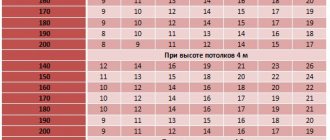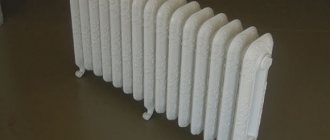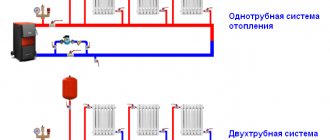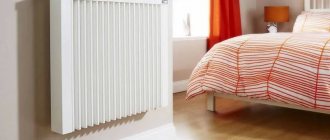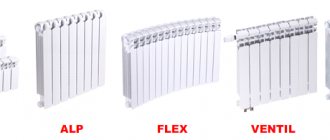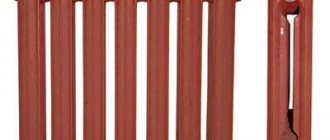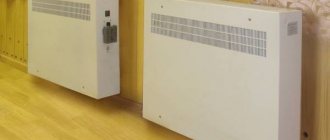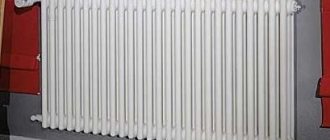A bimetallic radiator is a heating device in which coolant circulates through a steel core placed inside an aluminum casing. Batteries of this type belong to sectional heating devices and operate on the principle of combined (convective and radiant) heat exchange.
The technical characteristics of bimetallic heating radiators include a number of parameters and design features that allow you to evaluate the heating device and compare it with other models of a similar size.
How to correctly compare bimetallic radiators with each other?
Anyone who carefully approaches the choice of heating batteries for their home or apartment strives to purchase products with optimal performance and technical characteristics. To correctly select the most suitable radiator, the models being compared must be of the same size. In the reference data, the parameters are given for one section, so you need to compare not the devices as a whole, but their structural parts. The main parameter by which the division into standard sizes occurs is the interaxle distance.
Radiators with different center distances.
The center distance is the size between the axis of the upper and lower collector. Like all-aluminum models, bimetallic heating radiators are mainly produced with a center distance from 200 to 800 mm. Models with a large center distance, and as a consequence, with an increased section height (but a smaller width of the entire radiator), are rare. They are used if the interior features of the room do not allow placing a horizontally located device.
The device of a bimetallic radiator.
Geometric parameters
The main geometric characteristics of a bimetallic radiator are its height, as well as the width and depth of the section. The height, as a rule, is 60 - 80 mm higher than its center distance.
Most manufacturers produce models with a section width of 80 mm. Knowing the number of sections, you can easily determine the total width of the device.
The depth of the section is 80 – 100 mm. The radiator can be either constant depth or varying in height, like the stylish and elegant DreamLiner series device from Royal Thermo.
Installation of a heating radiator on a wooden wall.
Thermal power
This parameter allows you to determine how many radiator sections of a particular model are needed to heat a room of a certain area. Thermal power is measured in Watts and is at an interaxial distance:
- 500 mm – from 170 to 200 W;
- 350 mm – from 120 to 140 W;
- 300 mm – from 100 to 145 W;
- 200 mm – about 100 W.
In their information and technical materials (instructions, manuals, catalogs), manufacturers indicate tables showing the number of sections optimal for heating rooms of various sizes.
The steel core is the basis of the structure.
Volume (capacity) of one section
In bimetallic radiators, coolant circulates through steel cores. The core is an H-shaped welded structure consisting of an upper and lower collector connected to each other by a vertical tube (heat pipe). Each manifold has two side holes with internal threads, thanks to which the sections can be connected using steel nipples. This design completely eliminates contact of the coolant with aluminum.
Unlike aluminum radiators, where the heat pipe has an oval cross-section, the steel cores of bimetallic models use exclusively round tubes, which provides for a smaller capacity of each section. Thus, the bimetallic Rifar Base 500 has a section capacity of 0.20 liters, while the aluminum Rifar Alum 500 model of the same size has a volume of 0.27 liters.
Section of the device in section.
Section weight
Bimetallic radiators have more mass than similar models of aluminum radiators. This is explained by the use of steel cores in their design, the density of which (and therefore the mass) exceeds that of aluminum. For example, the bimetallic radiator Varmega Bimega 500/80 weighs 1.75 kg, and the aluminum radiator Almega 500/80 from the same manufacturer weighs 1.2 kg.
Pressure
The operating pressure of bimetallic radiators is 16 – 40 atm (1.6 – 4.0 MPa). According to regulatory documents, devices must be tested by pressure testing the heating system with a pressure 1.5 times higher than the operating value. The documentation also indicates the value of the maximum pressure, upon reaching which it can begin to collapse.
Connection of sections.
Battery sizes
The dimensions of the device are important, since with the required power parameters it must fit in a niche under the window. What sizes can bimetallic batteries have?
Bimetallic heating radiators are characterized by standard height dimensions. The device has a marking that indicates the center distance of the device - 200, 350 or 500 mm.
Important! When choosing a radiator, it is necessary to take into account that the center distance is the gap between the inlet and outlet holes of the battery, which does not correspond to the entire height of the case. To find out the actual height of the device, you need to add 80 mm to the center distance.
Full height of the device with different markings:
- marking 200 – actual height 280 mm;
- 350 – device height 430 mm;
- 500 – height 580 mm.
USEFUL INFORMATION: Stages and features of apartment renovation in new buildings from scratch
The width of the heating device will depend on the number of sections, which is calculated based on the parameters of the room and the power of the individual section.
Attention! When choosing the size of the radiator, do not forget that, in accordance with technical standards, the device must be installed at a distance of at least 10 cm from the window sill and 6 cm from the floor.
Comparative technical characteristics of bimetallic radiators
For convenient comparison of different models, tables 1-3 contain data on the main characteristics of products from 11 manufacturers. The information is provided both for the most common standard size of 500 mm, and for radiators with center distances of 350, 300 and 200 mm, which are present in the model range of only some manufacturers.
Table 1 - Comparison of characteristics of models with an interaxial distance of 500 mm.
| Manufacturer and model | Overall dimensions, mm | Section volume, l | Section weight, kg | Pressure, atm | Thermal power, W | |||
| height | width | depth | working | test | ||||
| Bilux plus R500 | 563 | 80 | 85 | 0,21 | 1,82 | 20 | 30 | 182 |
| Industry Pasotti Elegance Wave Bimetallico | 565 | 80 | 100 | 0,19 | 2,06 | 35 | 52 | 176 |
| Global Style Extra 500 | 566 | 81 | 80 | 0,21 | 1,87 | 35 | 52,5 | 170,7 |
| Conner Bimetal 80/500 | 563 | 80 | 80 | 0,40 | 2,18 | 30 | 45 | 190 |
| Rifar Base 500 | 570 | 79 | 100 | 0,20 | 1,92 | 20 | 30 | 204 |
| Royal Thermo BiLiner 500 | 574 | 80 | 87 | 0,205 | 2,01 | 30 | 45 | 171 |
| Tenrad BM500 | 550 | 80 | 75 | 0,22 | 1,45 | 24 | 36 | 161 |
| Varmega Bimega 500/80 | 565 | 80 | 80 | 0,3 | 1,75 | 30 | 45 | 190 |
| Santekhprom RBS-500 | 560 | 80 | 95 | 0,23 | 2,34 | 16 | 24 | 185 |
| Sira Industry RS Bimetal 500 | 572 | 80 | 95 | 0,199 | 2,03 | 40 | 60 | 201 |
| Scola JB-SA 500 | 565 | 78 | 80 | 0,28 | 1,85 | 30 | 40 | 188 |
Variety of standard sizes.
Table 2 - Comparison of characteristics of models with an interaxle distance of 350 mm.
| Manufacturer and model | Overall dimensions, mm | Section volume, l | Section weight, kg | Pressure, atm | Thermal power, W | |||
| height | width | depth | working | test | ||||
| Global Style Extra 350 | 416 | 81 | 80 | 0,17 | 1,42 | 35 | 52.5 | 119.6 |
| Conner Bimetal 80/350 | 413 | 80 | 80 | 0,30 | 1,28 | 30 | 45 | 140 |
| Rifar Base 350 | 415 | 80 | 90 | 0,18 | 1,36 | 20 | 30 | 136 |
| Royal Thermo BiLiner 350 | 424 | 80 | 87 | 0,175 | 1,52 | 30 | 45 | 118 |
| Tenrad BM350 | 400 | 80 | 75 | 0,15 | 1,18 | 24 | 36 | 120 |
| Varmega Bimega 350/80 | 412 | 80 | 80 | 0,22 | 1,43 | 30 | 45 | 140 |
Curved radiator for bay windows.
Table 3 - Technical characteristics of bimetallic radiators with center distances of 300 and 200 mm.
| Manufacturer and model | Overall dimensions, mm | Section volume, l | Section weight, kg | Pressure, atm | Thermal power, W | |||
| height | width | depth | working | test | ||||
| Center distance 300 mm | ||||||||
| Bilux plus R300 | 365 | 80 | 85 | 0,17 | 1,29 | 20 | 30 | 142 |
| Santekhprom RBS-300 | 360 | 80 | 95 | 0,178 | 1,67 | 16 | 24 | 121 |
| Sira Industry RS Bimetal 300 | 372 | 80 | 95 | 0,165 | — | 40 | 60 | 145 |
| Scola JB-SA 300 | 365 | 78 | 80 | — | 1,45 | 30 | 40 | 106 |
| Center distance 200 mm | ||||||||
| Bilux plus R200 | 550 | 80 | 75 | 0,22 | 1,45 | 24 | 36 | 161 |
| Rifar Base 200 | 565 | 80 | 80 | 0,3 | 1,75 | 30 | 45 | 190 |
Materials used
The core of the bimetallic radiator section is made of steel pipes. For batteries of normal strength (working pressure 16 - 20 atm), the core is made of carbon steel grade St.3 or its foreign analogues (for example, Tenrad radiators). The core (frame) of high-strength models is welded from stainless steel pipes. High-strength devices with a stainless steel core (for example, Biliner from Royal Thermo) can withstand burst pressures of more than 100 atm.
The outer part of bimetallic radiators is made of aluminum by injection molding. The extrusion method used in the production of some aluminum models cannot be used in this case, since a core must be placed inside the workpiece before forming begins. O-rings are made from heat-resistant silicone rubber.
Profiled fins.
How to calculate radiator power
Dependence on the number of pipes
No matter how high-quality the batteries are, they will not be able to provide the necessary heat transfer if the initial calculation of the power and number of sections was carried out incorrectly. The basis of calculations is the power of one section. It is indicated by the manufacturer in the specifications for the product. But it is necessary to take into account that average indicators may differ significantly from real ones.
To calculate heat transfer, the parameter ∆t is used, which is the difference between the air temperature in the heated room and the temperature in the system. In practice, this figure rarely exceeds ∆t 50°C. At the same time, it is declared by manufacturers as ∆t 70 °C, which represents ideal conditions.
When calculating, it is necessary to take into account other data:
- The location of the room in the house.
- Condition of building structures.
- Sizes and location of windows and doors.
- The materials from which the house is built.
- Type of boiler equipment used, etc.
The simplest calculation can be made using the formula - the area of the room multiplied by 100 and divided by the power of one section. For example, to effectively heat a room of 25 square meters. m requires 16 sections. This figure is obtained from a simple calculation - 25 × 100/150.
Fins
The fins serve to increase the total heat transfer area of the heating device. Modern models use various design solutions that make fins more efficient.
The efficiency of heat transfer is increased by introducing additional fins into the structure, as well as by profiling convection channels between the ribs. In Tenrad radiators, the channels form a confuser, due to which the air flow speed increases, which increases the intensity of convective heat transfer. The outer edges of the ribs are rounded to increase injury safety.
Six-section radiators.
Method of connecting sections
In bimetallic heating radiators, the sections are connected to each other using steel threaded nipples. In the manufacture of Monolit series radiators from the Rifar company, another type of connection is used - welding. This model of heating devices can withstand increased pressure (operating up to 100 atm) and temperature (up to 135°C versus 110°C for nipple models).
Diagram of a monolithic radiator.
Bimetallic radiators are the most technically advanced heating device for water heating systems. Combining high efficiency and good performance indicators, devices of this type are optimal for use in domestic conditions. Knowing the technical characteristics of bimetallic heating radiators of various models, you can choose a heating device that best suits the operating conditions in a particular room.
Comparison of bimetallic and aluminum radiators
The power of the aluminum and bimetallic radiator sections is identical. which gives them the same performance, but there are some differences in characteristics
What you should pay attention to when choosing batteries
- Reliability - for an autonomous heating system in which there is no threat of water hammer, aluminum equipment will be sufficient, but if it is intended to be used in a centralized heating system, it is better to play it safe and choose bimetal as it is more resistant. It is guaranteed to withstand even a serious jump and will not leak.
- Cost is one of the most important criteria, which often outweighs any arguments. The cost of aluminum radiators is on average two times lower than the cost of bimetallic radiators, with equal characteristics. If we compare the price-quality ratio, aluminum wins, but subject to control of the pressure in the system.
Both bimetallic and aluminum radiators will meet their characteristics only if they are produced using modern equipment and according to technology. You should not try to save money and purchase a surprisingly cheap model from a little-known manufacturer. Probably its quality, regardless of the material, leaves much to be desired.
Rating: 0 Votes: 0
To ensure optimal performance of the heating system, the number of radiator sections per heated area is calculated. Quite often it turns out that a standard radiator is not enough and sections need to be added, otherwise the heating will not be effective. Let's look at how to use soy correctly.
To get the most efficient heating system with high efficiency and minimal energy consumption, it is necessary not only to select the most suitable radiators, but also to perform the correct installation. Given the increased popularity of bimetallic batteries, let's take a closer look at their connection. P.
In this article we will look at what is better: a radiator or a convector for a reliable and economical option for heating both your apartment and a private home; we will list several reliable and trusted manufacturers that you can trust to heat your home. The question of reliable heating faces many people.
A thermal valve for a heating radiator is a very necessary addition, without which your heating system will not work fully. More precisely, it will work, but it will be impossible for you to regulate the temperature of the system and, accordingly, the temperature in the room. In order to.
